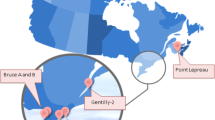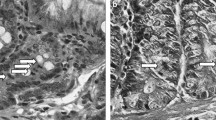Abstract
Effective provisions of preparedness and response are necessary to protect human life, health, property, and the environment in any nuclear and radiological emergency. Recently, the International Commission on Radiological Protection recognized the need to provide more quantitative guidance on environmental radiation protection to integrate these analyses. A required assessment is a correlation between dose and its effects in non-human biota. Plants are highly sensitive environmental monitors for the assessment of potentially genotoxic agents and avoid the controversial use of animal models. The Allium test is commonly used to assess genotoxicity for a wide variety of chemical and physical factors, as it allows for estimates of possible DNA damage in eukaryotes in general, including humans. In this work, onion (Allium cepa) seedlings were exposed to 20–200 mGy of \(\alpha\)-radiation. We studied the possibility of using cytogenetic analyses of irradiated onion cells to determine the biological dose. It was observed that the increase in the frequencies of chromosomal aberrations, mitotic abnormalities, and micronuclei occurred proportional to the radiation dose, but a reduction in cytological damage was observed from 100 mGy, suggesting the onset of cytotoxic activity. Our research shows the potential of Allium cepa as a sensitive support system for dosimetry, detection, and screening of cellular effects produced by low doses of environmental radiation.




Similar content being viewed by others
References
F.R. Tang, K. Loganovsky, Low dose or low dose rate ionizing radiation-induced health effect in the human. J. Environ. Radioact. 192, 32–47 (2018)
D. Averbeck, S. Salomaa, S. Bouffler, A. Ottolenghi, V. Smyth, L. Sabatier, Progress in low dose health risk research: Novel effects and new concepts in low dose radiobiology. Mutat. Res. 776, 46–69 (2018)
IAEA, Cytogenetic Dosimetry: applications in preparedness for and response to radiation emergencies. (IAEA, Vienna, 2011).
S. Senthamizhchelvan, G.S. Pant, G.K. Rath, P.K. Julka, O. Nair, Biodosimetry using micronucleus assay in acute partial body therapeutic irradiation. Eur. J. Med. Phys. 25(2), 82–87 (2009)
G. Köksal, D.O. Dalcí, F.S. Pala, Micronuclei in human lymphocytes: the Co-60 gamma-ray dose-response. Mutat. Res. 359(2), 151–157 (1996)
F. Zölzer, Z.F. Skalická, R. Havránková, Z. Hon, L. Navrátil, J. Rosina, J. Skopek, Enhanced frequency of micronuclei in lymphocytes from current as opposed to former uranium miners. J. Appl. Biomed. 9(3), 151–156 (2011)
A.D. da Cruz, A.G. McArthur, C.C. Silva, M.P. Curado, B.W. Glickman, Human micronucleus counts are correlated with age, smoking, and cesium-137 dose in the Goiânia (Brazil) radiological accident. Mutat. Res. 313(1), 57–68 (1994)
Y. Chen, P.-K. Zhou, X.-Q. Zhang, Z.-D. Wang, Y. Wang, F. Darroudi, Cytogenetic studies for a group of people living in Japan 1 year after the Fukushima nuclear accident. Rad. Prot. Dosimy. 159(1–4), 20–25 (2014)
B. Ponnaiya, G. Jenkins-Baker, A. Bigelow, S. Marino, C.R. Geard, Detection of chromosomal instability in α-irradiated and bystander human fibroblasts. Mutat. Res. 568(1), 41–48 (2004)
A. Testa, V. Palma, C. Patrono, Dicentric chromosome assay (DCA) and cytokinesis-block micronucleus (CBMN) assay in the field of biological dosimetry. Methods Mol. Biol. 203(1), 105–119 (2019)
A. Ulanovsky, Dosimetry for animals and plants: contending with biota diversity. Ann. ICRP 45(1 Suppl), 225–238 (2016)
K.A. Higley, Integration of radiological protection of the environment into the system of radiological protection. Ann. ICRP 47(3–4), 270–284 (2018)
D.M. Leme, M.A. Marin-Morales, Allium cepa test in environmental monitoring: a review on its application. Mutat. Res. 682(1), 71–81 (2009)
G.M. Ludovici, S.O. Souza, A. Chierici, M.G. Cascone, F. d'Errico, A. Malizia, Adaptation to ionizing radiation of higher plants: from environmental radioactivity to Chernobyl disaster. J. Environ. Radioact. 222, 106375 (2020)
S.B. Tedesco, H.D. Laughinghouse IV., Bioindicator of genotoxicity: the Allium cepa test. Environ. Contam. (2012). https://doi.org/10.5772/31371
E. Bonciu, F. Peter, C.S. Fontanetti, J. Wusheng, M.C. Karaismailoğlu, D. Liu, F. Menicucci, D.S. Pesnya, A. Popescu, A.V. Romanovsky, S. Schiff, J. Ślusarczyk, C.P. Souza, A. Srivastava, A. Sutan, A. Papini, An evaluation for the standardization of the Allium cepa test as cytotoxicity and genotoxicity assay. Caryologia 71(3), 191–209 (2018)
L. Kovalchuk, The Allium cepa chromosome aberration test reliably measures genotoxicity of soils of inhabited areas in the Ukraine contaminated by the Chernobyl accident. Mutat. Res. 415, 47–57 (1998)
S.G. Vaijapurkar, D. Agarwal, S.K. Chaudhuri, K.R. Senwar, P.K. Bhatnagar, Gamma-irradiated onions as a biological indicator of radiation dose. Radiat. Meas. 33, 833–836 (2001)
M. Saghirzadeh, M.R. Gharaati, Sh. Mohammadi, M. Ghiassi-Nejad, Evaluation of DNA damage in the root cells of Allium cepa seeds growing in soil of high background radiation areas of Ramsar – Iran. J. Environ. Radioact. 99(10), 1698–1702 (2008)
A. Bolsunovsky, D. Dementyev, E. Trofimova, E. Iniatkina, Y. Kladko, M. Petrichenkov, Chromosomal aberrations and micronuclei induced in onion (Allium cepa) by gamma-radiation. J. Environ. Radioact. 207, 1–6 (2019)
D. Bowler, S. Moore, D. Macdonald, S. Smyth, P. Clapham, M. Kadhim, Bystander-mediated genomic instability after high LET radiation in murine primary hemopoietic stem cells. Mutat. Res. 597, 50–61 (2006)
R.B. Firestone, Table of Isotopes, 8th edn. (Wiley, New York, 1996)
ICRU, Tissue substitutes in radiation dosimetry and measurement. (ICRU – Report 44, United States, 1989).
J. Van’t Hof, Relationships between mitotic cycle duration, S period duration, and the average rate of DNA synthesis in the root meristem cells of several plants. Exp. Cell Res. 39, 48–58 (1965)
M. Guerra, M.J. Souza, Como Observar Cromossomos: Um Guia de Técnicas Em Citogenética Vegetal, Animal e Humana (São Paulo, FUNPEC, 2002)
D.R. Brillinger, in The Collected Works of John W. Tukey: Time Series 1965–1984, vol. II, ed. by D.R. Brillinger (Chapman & Hall, London, 1984)
Ø. Hammer, D.A.T. Harper, P.D. Ryan, Past: paleontological statistics software package for education and data analysis. Palaeontol. Electron. 4(1), 1–9 (2001)
R. Ren, M. He, C. Dong, Y. Xie, S. Ye, D. Yuan, C. Shao, Dose response of micronuclei induced by combination radiation of α-particles and γ-rays in human lymphoblast cells. Mutat. Res. 741–742, 51–56 (2013)
M. Tkalec, K. Malaric, M. Pavlica, B. Pevalek-Kozlina, Z. Vidakovic-Cifrek, Effects of radiofrequency electromagnetic fields on germination and root meristem of Allium cepa L. Mutat. Res. 672(2), 76–81 (2009)
M. Barisic, H. Maiato, The mitotic spindle. Encycl. Cell Biol. 2, 637–648 (2016)
Acknowledgements
This research was supported by the Brazilian agencies CNPq, CAPES, and FAPITEC-SE.
Author information
Authors and Affiliations
Corresponding author
Ethics declarations
Conflict of interest
The authors report no conflicts of interest.
Rights and permissions
About this article
Cite this article
Xavier, M.N., Pantaleão, S.M., Scher, R. et al. Allium cepa used as a dosimetry system in nuclear and radiological emergencies. Eur. Phys. J. Plus 136, 682 (2021). https://doi.org/10.1140/epjp/s13360-021-01674-8
Received:
Accepted:
Published:
DOI: https://doi.org/10.1140/epjp/s13360-021-01674-8




